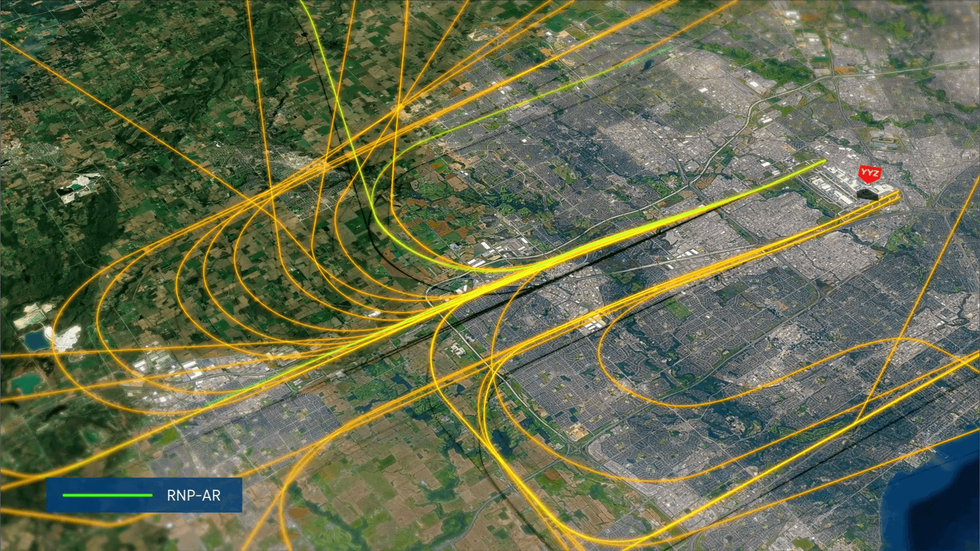Toronto Pearson Airport Has A New Landing Procedure That Will Make Flights Shorter & Quieter
It's among many recent improvements announced at YYZ.

A plane flying over a busy street as it comes in for landing at Toronto Pearson Airport.
A new procedure has come into effect at Toronto Pearson International Airport (YYZ) that will apparently make flight times shorter and also be a bit more kind to the environment.
Nav Canada has introduced a new landing procedure on Canada's busiest runway, and it first took effect this week.
The new system uses "satellite-based positioning and modern aircraft flight management systems" to allow planes to arrive simultaneously on runways that are parallel to each other, making routes more direct and efficient, according to a news release.
Tuesday's announcement of the new procedure is one of many improvements recently announced at Toronto Pearson, including a newly reopened runway and an online airport security appointment booking system.
"Yesterday, @AirCanada flight 855, which flew from @HeathrowAirport to @TorontoPearson, was one of the first flights to use RNP-AR in Toronto," Nav Canada said in a tweet.
\u201cYesterday, @AirCanada flight 855, which flew from\n@HeathrowAirport to @TorontoPearson, was one of the first flights to use RNP-AR in Toronto. Learn how this new landing procedure can help decrease emissions and flight times: https://t.co/4PsUYrT4Sg\u201d— NAV CANADA (@NAV CANADA) 1669746055
The video showed flight 855 looping around for a landing instead of joining the long line of planes approaching the runway one by one behind each other.
It was able to do this using technology called Required Navigation Performance – Authorization Required (RNP-AR), technology that can map a safe route for a flight among the many that are bound for the tarmac at Pearson at any given time.

Until now, planes that landed on parallel runways had to be a longer distance apart, both vertically and laterally, which forced some to fly at a lower altitude over communities or on a longer trajectory, which made flight times longer.
It's not clear how much quicker the average flight would be if it landed with this procedure, but it's not uncommon to look up in the sky and see quite the long lineup of planes coming in for landing.
Nav Canada said this new technology will solve both problems and also reduce fuel burn, which is estimated to reduce greenhouse gas emissions from Pearson by 178 million kilograms.
“Our goal is to ensure aircraft transit to their destination on the safest and most efficient path possible, while also respecting local communities and reducing the overall impact on the environment,” said Blake Cushnie, the Program Director at NAV CANADA. “The project at Toronto Pearson is designed to achieve just that and we believe this concept will eventually become the new normal at other major international airports globally."
This new procedure was first introduced at the Calgary International Airport (YYC) in 2018, and today, roughly 40% of aircraft are equipped with this technology.
- Toronto Pearson Airport Reopens Renovated Runway & It Could Make Holiday Travel Easier ›
- Pearson Airport Has A New Online Booking System That Will Get You Past Security Faster ›
- Pearson Airport Was Named Most Stressful Airport In North America & It's An 'Embarrassment' ›
- These Are The 'Most Stressful' Airports In Canada That You'll Probably Want To Avoid - Narcity ›
- Porter Airlines Will Start Flying Out Of Pearson Airport This Month & Lots Is Changing - Narcity ›
- Porter Airlines Will Fly To Vancouver From Pearson Airport In 2023 & Tickets Start At $121 - Narcity ›
- Porter Airlines Will Fly To Vancouver From Pearson Airport In 2023 & Tickets Start At $121 - Narcity ›
- You Could Make Up To $25 An Hour As A Pre-Boarding Screening Officer At Pearson Airport - Narcity ›